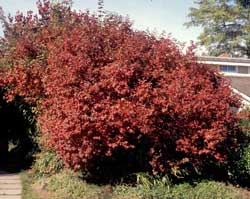Landscape Shrubs
Cranberrybush viburnum
(Virburnum trilobum)
Cranberrybush viburnum technically can be one of two similar-looking species: either Viburnum opulus, the European cranberrybush viburnum, or V. trilobum, the American cranberrybush viburnum. The minor differences boil down to minutia of leaf shape and the shape of a very small gland near the base of the leaf. From a practical standpoint, both are equally great deciduous shrubs.
Attractive white flowers appear in late April/early May. The inflorescence, which is about 4”–5” in diameter, consists of an outer ring of showy sterile flowers surrounding a core of small, fertile flowers. The outer, sterile flowers look like popped popcorn. In the case of the cultivar ‘Roseum’ for V. opulus, the majority of flowers are sterile, so the overall effect is a “snowball.” Be careful using the name “snowball viburnum”—it is also used for other viburnums, such as V. plicatum or V. macrocephalum (Chinese snowball viburnum). There is also something troubling about the cultivar name ‘Roseum,’ since it suggests the plant has red flowers, which is not true. Nevertheless, the cultivar is spectacular and may draw many spectators to your yard.
Starting in August and continuing through October, those plants with fertile flowers come back to life with a showy fruit display. The ¼”-diameter, berry-like drupe is the clearest lipstick red you will ever see. If wildlife does not eat the fruits, they will persist into winter and then shrivel into a dull orange raisin-like fruit. Cultivars such as ‘Wentworth’ and ‘Hahs’ were selected for larger fruits but may be hard to find in the trade. There are a few hard-to-find cultivars with yellow fruits (V. opulus ‘Xanthocarpum’).
Leaves during the growing season are a medium green. The leaf shape will remind you of a sugar maple. These plants have the potential for nice maroon fall color; however, like many other plants in the South, the color is not typically as reliable or intense as would be seen in northern states.
So far we have mentioned that this plant offers us options in flower type: a mix of sterile and fertile flowers or mostly all showy, sterile flowers. Both the American and European also offer us options in plant size. ‘Compactum’ American cranberrybush viburnum offers an excellent, tight plant habit and yet still offers good flowering and fruiting. The compact form (‘Compactum’) of the European species is very similar. In contrast, the cultivar ‘Nanum’ of the European viburnum is a different beast. ‘Nanum’ is generally even a tighter plant habit and seems to flower and fruit less than ‘Compactum.’ For those who like a neat, tight ball-shaped plant, ‘Nanum’ is your ticket. Except for the fact that it is deciduous, this cultivar would work well in a formal, low hedge in the same situations where we use evergreen Korean boxwood (Buxus microphylla v. koreana).
The ideal setting in Arkansas would be partial sun for best flowering and fruiting. While a good soil is best, these plants will tolerate boggy soils. Like many other viburnums, these plants would benefit from a regular schedule of renewal pruning to remove the largest branches at ground level.
While a few insect problems are possible, I doubt they would be significant in Arkansas. Depending on whether you select the species or one of the more compact cultivars, these plants offer many options in the landscape from a single filler shrub to a low/medium border. Admittedly, this deciduous plant may be more favored in the northwest part of Arkansas.
- Common Name: cranberrybush viburnum
- Varieties to look for: ‘Roseum,’ ‘Nanum,’ ‘Compactum’
- Flower Color: white
- Blooming period: April/May
- Perennial or annual: deciduous woody shrub
- Size: 9’ tall by 9’ wide
- Exposure: partial sun
- Soil: fairly adaptable
- Watering: moist best
- When to prune: late fall
- Suggested use: massed, specimen, filler, low hedge
Form and flowers
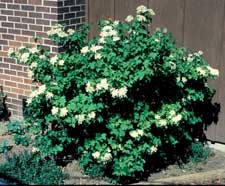
Leaf and fruit
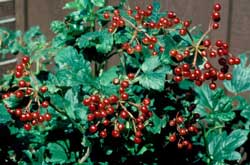
'Roseum' leaf and flowers
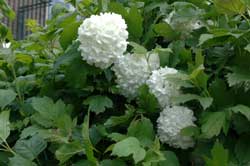
Leaf and flowers
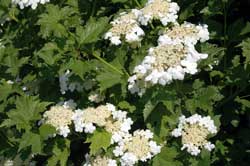
Fall color
